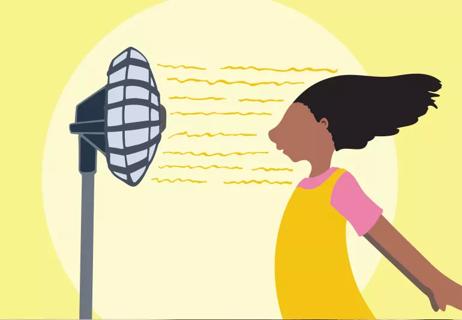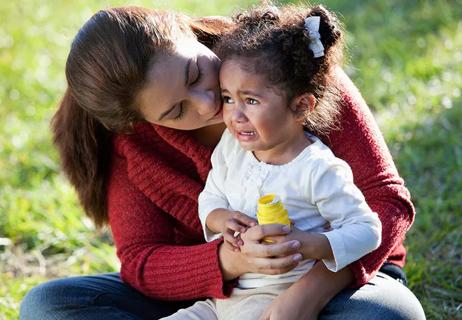From allergies to anxiety, excessive blinking usually isn’t a concern

It can be a disconcerting look. Did your toddler just wink at you? Are they blinking on purpose? Is there a problem with their eyes?
Advertisement
Cleveland Clinic is a non-profit academic medical center. Advertising on our site helps support our mission. We do not endorse non-Cleveland Clinic products or services. Policy
When your child’s blinking goes into overdrive, you might stop and wonder, What’s that all about?
Your kid may be blinking excessively for a number of reasons, says pediatrician Lisa Diard, MD.
Dr. Diard explains why your toddler, or older child, might be blinking a lot, and how you can help.
For starters, blinking is a natural physiological reaction, and it plays an important role in our eye health.
“Blinking is a normal reflex that refreshes and protects your eyes,” Dr. Diard states. “When you blink, you spread your tears around, which helps clean and lubricate your eyes. Blinking also helps protect your eyes from bright lights and foreign objects.”
But how do you know if your toddler is blinking too much? Don’t use your own blinking norms as the standard. Dr. Diard says kids naturally blink more than adults.
Use a timer to get some quantitative data. For toddlers, more than 15 blinks per minute would be considered a lot. (In case you’re wondering, researchers say adults tend to blink about 12 times per minute.)
OK, so, now you know something is up. Junior’s blinking is out of control. And you know what? Now that you’re thinking about blinking, maybe you’re doing it, too (funny how that happens, right?).
Advertisement
Dr. Diard shares these seven reasons why your child may be blinking to the max.
Excessive blinking that comes on suddenly can be a natural response when we have something stuck in our eye — like, say an eyelash or a speck of dust or sand.
You can help flush out their eye at home, using clean tap water to wash out any potential debris.
Dr. Diard’s preferred method?
“Put the water in a small cup and put the cup around your child’s eye. Then tilt your child’s head back and have them blink as the water drips in their eye.”
While the method may require a bit of patience — and perhaps a bribe to ensure cooperation — it can definitely do the trick.
If you have allergies, you know the feeling. Dry eyes can leave you blinking or rubbing your eyes more than usual.
Dr. Diard notes that there are some telltale signs that allergies may be causing your child’s excessive blinking. Look out for symptoms like:
“If all signs point to allergies, try giving your toddler an allergy medicine. Oral medications and eye drops both work well,” says Dr. Diard.
Not all dry eyes are connected to allergies. Dry weather and pollutants in the environment can also contribute to dry eyes and excessive blinking in children.
A humidifier can help if the air in your home is dry, particularly when it’s cold out. It can also help to have your child rest their eyes if they’re feeling itchy, but encourage them not to rub them. Artificial tear drops for kids can also help.
Blinking a lot can be one sign that you may want to consider a vision screening for your child.
“Sometimes, children blink more when they’re trying to focus their eyes,” Dr. Diard warns.
Other signs of a potential vision problem in children include:
Children with crossed eyes may blink more than other children. Crossed eyes usually appear by the time a toddler is about 3 years old. It may seem as if one eye is turned in a different direction from the other.
It’s common for newborns to appear to have crossed eyes. By a few months old, their eyes should be straight and aligned.
A tic is an uncontrollable movement or vocal sound. Motor tics can include things like excessive blinking and other simple movements, too, like moving your jaw, turning your head or shrugging your shoulders.
Advertisement
Tics are more common in boys and typically start around the age of 5.
If you think your child’s excessive blinking is because of a tic, you may jump to the worry that they’re developing Tourette syndrome. In reality, though, childhood tics, including blinking tics, are relatively common. Most go away on their own by adolescence.
Dr. Diard says that ignoring the habit is usually the route to take, unless there’s a reason behind the tic.
“If we know there’s an underlying anxiety behind the tic, we would have you work with a child behavioral specialist to help your child learn ways to cope.”
Some children who are experiencing stress or anxiety may blink more. Anxiety can exacerbate an eyelid tic. Alternatively, living with stress and anxiety can make you more sensitive to light and eye strain, leading to excess blinking.
If you’ve ruled out things like allergies and debris in their eye, Dr. Diard advises that it’s usually best to get excessive blinking checked out by a healthcare provider. Especially if your child is experiencing pain or anxiety or if the blinking continues over an extended period of time.
A call to the pediatrician’s office can suffice in most situations. More concerning signs should prompt a visit to the urgent care or emergency room for more immediate concerns, like if your child’s eye has been scratched. Signs that you should seek prompt care include:
Advertisement
To diagnose your toddler, a pediatrician will examine their eyes and screen your child’s vision to make sure there’s nothing urgent.
“Your healthcare provider may also recommend seeing an ophthalmologist as well. They have the tools to examine the eyes more closely,” says Dr. Diard.
But rest assured, a blinking habit is usually harmless — and one on a long list of things your toddler will outgrow.
Advertisement
Learn more about our editorial process.
Advertisement

Stay calm, don’t give in and try to refocus their attention

They’re nontoxic, but crayons can cause an upset stomach and pose a serious choking hazard

Regular dental checkups should start around their first birthday

Remove any extra clothing, apply a cold washcloth and move them into a cooler area

Teething and frustration can make the ‘terrible 2s’ an unfortunate reality

These little batteries can do severe damage — go to the ER immediately

Reduce frustration and get more sleep

Find out how to head off unruly behavior

Leg-related symptoms indicate DVT, while chest symptoms point to a pulmonary embolism

There are many different ways to love someone and yourself

Looking down at your smartphone or computer screen can stress muscles in your neck, shoulders and back